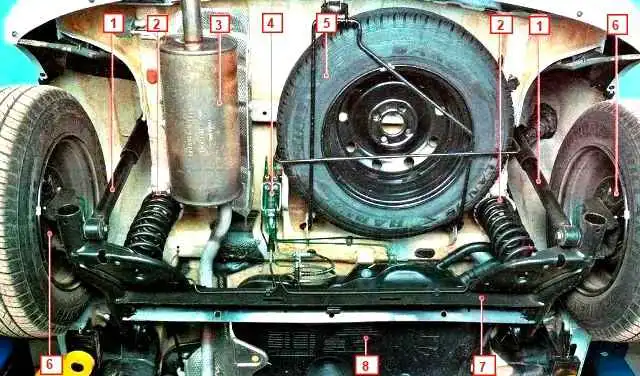Renault/Dacia Sandero rear suspension semi-independent with an elastic beam, spring-loaded with double-acting telescopic hydraulic shock absorbers.
Brackets for spring support are welded to the beam and levers.

A torsion-type anti-roll bar can be installed in the suspension beam.
Flanges are welded to the suspension arms for mounting the axles of the rear wheels and the shields of the brake mechanisms.
Front, the levers are equipped with welded bushings with silent blocks pressed into them.
The outer sleeve of the silent block is plastic, and the inner sleeve is metal.
The rubber mass of the silent block, vulcanized to the bushings, is asymmetrical in cross section.
Therefore, when pressing the silent block into the lever, it must be strictly oriented.

The elastic elements of the suspension are coil springs.
The spring rests through rubber gaskets: from below - on the lever bracket and from above - on a support welded to the body side member. The lower coil of the spring has a smaller diameter.
Rear suspension springs are divided into classes according to stiffness.
Spring class is marked with paint.
Springs of the same class must be installed on the right and left sides of the car.
When replacing, it is recommended to install springs of the same class that were installed on the car.
A rubber-metal hinge is pressed into the lower eye of the shock absorber, through the central bushing of which a bolt passes, securing the shock absorber to the suspension arm.
The shock absorber rod is attached to the body through two rubber pads (one at the bottom of the support, the other at the top) and two metal washers.
A spacer sleeve is installed between the cushions on the damper rod, which prevents the cushions from being excessively deformed when the stem nut is tightened.
The shock absorber is fitted with a compression stroke buffer to which the boot is attached.
Each rear wheel hub is mounted on two tapered roller bearings.
The installation angles of the rear wheels are specified by the beam geometry and cannot be adjusted in operation.
Angles can only be checked on a special stand and compared with control values.
If the values of the rear wheel alignment angles do not correspond to the control values, it is necessary to check the condition of the rear suspension elements.
Possible malfunctions of the rear suspension and solutions
Cause of malfunction - Remedy
Noise and knock in the suspension when the car is moving:
Shock absorber defective - Replace shock absorber
Loose shock absorber mounting or worn shock absorber lug bushing - Tighten the shock absorber lower mounting bolt and nut or replace the bushings
Worn trailing arm bushings - Replace bushings
Settlement or broken spring - Replace spring
Faulty wheel bearing - Replace bearing
Moving the car away from straight ahead:
Inflated tire pressure - Set correct tire pressure
Wheel tires have different wear or tread pattern - Change tires
Camber out of alignment - Eliminate cause of camber out of alignment
Settlement or breakage of one of the springs - Replace the spring
Deformation of trailing arms - Replace silent blocks
Increased or excessive tire tread wear:
Tire pressure not correct - Set correct pressure
Wheel Alignment Violated - Eliminate Causes of Violated Wheel Alignment
Overloading the vehicle - Avoid overloading the vehicle
Wheel imbalance - Balance wheels





